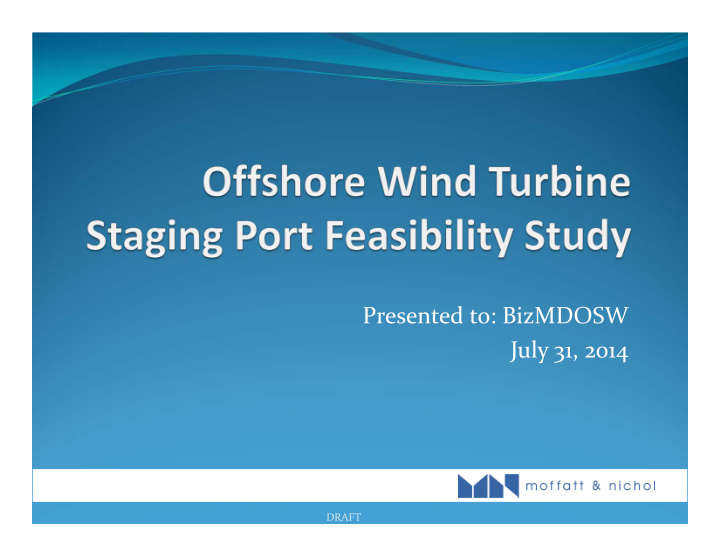



Presented to: BizMDOSW July 31, 2014 DRAFT
Study Objectives The objective of this study will be to identify suitable sites within Baltimore Harbor for an offshore wind power staging port and to solicit expressions of interest for developing one or more of these sites. The products of this effort will include: Criteria and assumptions that define site needs • A Base ‐ Case facility study and survey of selected Maryland sites • A formal presentation of findings and Request for Expressions of Interest from the • waterfront community These products will be generated through a general sequence of tasks that will define the needs, inventory the resources, inform the stakeholders, and promulgate a Request for Expressions of Interest (RFEI). This sequence will include the following general tasks: Definition of Needs and Port Criteria • Inventory of Existing Terminal Assets • Facility Plan Concepts • Terminal Operators Forum • Request for Expressions of Interest • DRAFT
Staging Port Functions Wind Turbine Generator Delivery Port Import wind turbine generators (WTG), consisting of the nacelle, hub, blades and tower, from Europe or Asia and offload from ocean ‐ going delivery vessel. Stockpile WTG components on ‐ terminal prior to installation. On ‐ port storage of WTG units acts as a buffer between the variable turbine delivery rate and the variable installation schedule. Minor on ‐ port value ‐ added functions can include: pre ‐ installation work on generator units and partial or total assembly of rotor units. Reload WTG units onto local delivery vessels or jackup installation vessels. Support Structure and Foundation Fabrication Port Import support structure components for: monopiles and transition pieces, jackets, and tripods. On ‐ port fabrication can range from post ‐ delivery preparation of subassemblies to complete construction using basic structural shapes. Other on ‐ port fabrication could include installation of J ‐ tubes, mooring platforms, accommodations ladders, and equipment; as well as surface prep and coatings. Stockpile support structures prior to installation. Load ‐ out of foundation units to local delivery vessels or installation vessels. DRAFT
Vessels Ocean ‐ Going Delivery Vessels Handy size – 400 ft. to 600 ft. Draft 30 ft. to 35 ft. Geared heavy lift or conventional Local Delivery Vessels Barge – 200 ft. to 400 ft. Draft 9 ft. to 18 ft. Requires towboat mooring Turbine Installation Vessels Jack ‐ up vessel 300 ft. to 500 ft. Draft 20 ft. plus leg clearance Can be self propelled or towed Foundation Installation Vessels Same size range as for turbines May deliver foundations or may work off of delivery barge. DRAFT
Port Requirements* Turbine Assemblies Weight Weight Unit Unit Notes: Min Max Load Storage (tons) (tons) (psf) Area (sqft) Tower 80 165 2,000 1,000 Stored vertically in sections Nacelle 180 375 4,000 2,000 Roughly 25 ft X 50 ft stored on support platform Blades 15 25 1,800 3,000 200 to 250 feet long stored horizontally Hub 20 35 1,800 400 6 meter diameter stored on blocks Rotor 40 110 1,800 na Assembled quay ‐ side and loaded on Assembly installation vessel Supports and Foundations Weight Weight Unit Unit Notes: Min Max Load Storage (tons) (tons) (psf) Area (sqft) Monopile 350 550 4,000 7,500 Unit load can be lower depending on storage mode Transition 300 350 2,000 1,000 Assembled and stored vertically Piece Jacket/Tripod 500 1,200 3,000 11,000 Assembled and stored vertically on blocks *DRAFT – Note: all numbers are approximate and subject to verification
Port Equipment Liebherr 11350 Heavy ‐ lift Crane – 1,350 metric tonne rated capacity Boom Length ‐ meters Reach from Swing ‐ Center ‐ meters DRAFT
Candidate Ports Rukert Terminal MPA ‐ Dundalk Terminal AmPorts/MAPC Sparrows Point Shipyard Sparrows Point Cianbro Kinder Morgan DRAFT
Recommend
More recommend